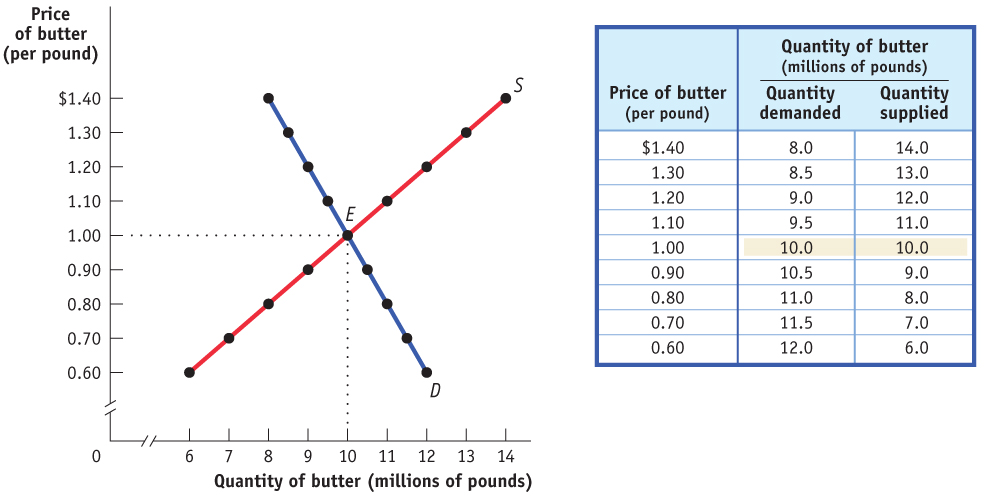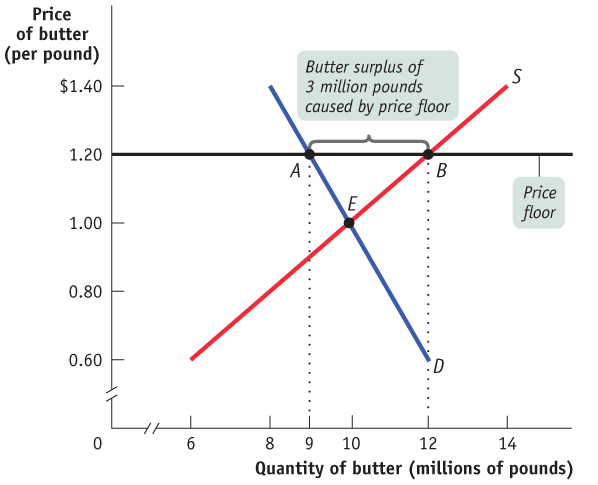Price Floors
The minimum wage is a legal floor on the hourly wage rate paid for a worker’s labor.
Sometimes governments intervene to push market prices up instead of down. Price floors have been widely legislated for agricultural products, such as wheat and milk, as a way to support the incomes of farmers. Historically, there were also price floors on such services as trucking and air travel, although these were phased out by the U.S. government in the 1970s. If you have ever worked in a fast-
Just like price ceilings, price floors are intended to help some people but generate predictable and undesirable side effects. Figure 8.3 shows hypothetical supply and demand curves for butter. Left to itself, the market would move to equilibrium at point E, with 10 million pounds of butter bought and sold at a price of $1 per pound.

86
Now suppose that the government, in order to help dairy farmers, imposes a price floor on butter of $1.20 per pound. Its effects are shown in Figure 8.4, where the line at $1.20 represents the price floor. At a price of $1.20 per pound, producers would want to supply 12 million pounds (point B on the supply curve) but consumers would want to buy only 9 million pounds (point A on the demand curve). So the price floor leads to a persistent surplus of 3 million pounds of butter.

Does a price floor always lead to an unwanted surplus? No. Just as in the case of a price ceiling, the floor may not be binding—
But suppose that a price floor is binding: what happens to the unwanted surplus? The answer depends on government policy. In the case of agricultural price floors, governments buy up unwanted surplus. As a result, the U.S. government has at times found itself warehousing thousands of tons of butter, cheese, and other farm products. (The European Commission, which administers price floors for a number of European countries, once found itself the owner of a so-
Some countries pay exporters to sell products at a loss overseas; this is standard procedure for the European Union. The United States gives surplus food away to schools, which use the products in school lunches. In some cases, governments have actually destroyed the surplus production. To avoid the problem of dealing with the unwanted surplus, the U.S. government typically pays farmers not to produce the products at all.
When the government is not prepared to purchase the unwanted surplus, a price floor means that would-
87
Price Floors and School Lunches
When you were in grade school, did your school offer free or very cheap lunches? If so, you were probably a beneficiary of price floors.
Where did all the cheap food come from? During the 1930s, when the U.S. economy was going through the Great Depression, a prolonged economic slump, prices were low and farmers were suffering severely. In an effort to help rural Americans, the U.S. government imposed price floors on a number of agricultural products. The system of agricultural price floors—
The big problem with any attempt to impose a price floor is that it creates a surplus. To some extent the U.S. Department of Agriculture has tried to head off surpluses by taking steps to reduce supply; for example, by paying farmers not to grow crops. As a last resort, however, the U.S. government has been willing to buy up the surplus, taking the excess supply off the market.
But then what? The government has to find a way to get rid of the agricultural products it has bought. It can’t just sell them: that would depress market prices, forcing the government to buy the stuff right back. So it has to give it away in ways that don’t depress market prices. One of the ways it does this is by giving surplus food, free, to school lunch programs. These gifts are known as “bonus foods.” Along with financial aid, bonus foods are what allow many school districts to provide free or very cheap lunches to their students. Is this a story with a happy ending?
Not really. Nutritionists, concerned about growing child obesity in the United States, place part of the blame on those bonus foods. Schools get whatever the government has too much of—

How a Price Floor Causes Inefficiency
The persistent surplus that results from a price floor creates missed opportunities—
Inefficiently Low Quantity Because a price floor raises the price of a good to consumers, it reduces the quantity of that good demanded; because sellers can’t sell more units of a good than buyers are willing to buy, a price floor reduces the quantity of a good bought and sold below the market equilibrium quantity. Notice that this is the same effect as a price ceiling. You might be tempted to think that a price floor and a price ceiling have opposite effects, but both have the effect of reducing the quantity of a good bought and sold.
Price floors lead to inefficient allocation of sales among sellers: those who would be willing to sell the good at the lowest price are not always those who manage to sell it.
Inefficient Allocation of Sales Among Sellers Like a price ceiling, a price floor can lead to inefficient allocation—but in this case inefficient allocation of sales among sellers rather than inefficient allocation to consumers.
Suppose you would be willing to sell your English tutoring services for $5 per hour, but the minimum wage is $9 per hour. The job might go to someone else who would tutor for $9 per hour but not for less. In this case, the price floor on wages prevents the worker who would sell tutoring services for the lowest amount from being able to do so.
Wasted Resources Also like a price ceiling, a price floor generates inefficiency by wasting resources. The most graphic examples involve government purchases of the unwanted surpluses of agricultural products caused by price floors. When the surplus production is simply destroyed, and when the stored produce goes, as officials euphemistically put it, “out of condition” and must be thrown away, it is pure waste.
88
Price floors also lead to wasted time and effort. Consider the minimum wage. Would-
Inefficiently High Quality Again like price ceilings, price floors lead to inefficiency in the quality of goods produced.
Price floors often lead to inefficiency in that goods of inefficiently high quality are offered: sellers offer high-
We’ve seen that when there is a price ceiling, suppliers produce goods that are of inefficiently low quality: buyers prefer higher-
How can this be? Isn’t high quality a good thing? Yes, but only if it is worth the cost. Suppose that suppliers spend a lot to make goods of very high quality but that this quality isn’t worth much to consumers, who would rather receive the money spent on that quality in the form of a lower price. This represents a missed opportunity: suppliers and buyers could make a mutually beneficial deal in which buyers got goods of lower quality for a much lower price.
A good example of the inefficiency of excessive quality comes from the days when transatlantic airfares were set artificially high by international treaty. Forbidden to compete for customers by offering lower ticket prices, airlines instead offered expensive services, like lavish in-
Since the deregulation of U.S. airlines in the 1970s, American passengers have experienced a large decrease in ticket prices accompanied by a decrease in the quality of in-

Illegal Activity Finally, like price ceilings, price floors provide incentives for illegal activity. For example, in countries where the minimum wage is far above the equilibrium wage rate, workers desperate for jobs sometimes agree to work off the books for employers who conceal their employment from the government—
So Why Are There Price Floors?
To sum up, a price floor creates various negative side effects:
a persistent surplus of the good
inefficiency arising from the persistent surplus in the form of inefficiently low quantity, inefficient allocation of sales among sellers, wasted resources, and an inefficiently high level of quality offered by suppliers
the temptation to engage in illegal activity, particularly bribery and corruption of government officials
So why do governments impose price floors when they have so many negative side effects? The reasons are similar to those for imposing price ceilings. Government officials often disregard warnings about the consequences of price floors either because they believe that the relevant market is poorly described by the supply and demand model or, more often, because they do not understand the model. Above all, just as price ceilings are often imposed because they benefit some influential buyers of a good, price floors are often imposed because they benefit some influential sellers.